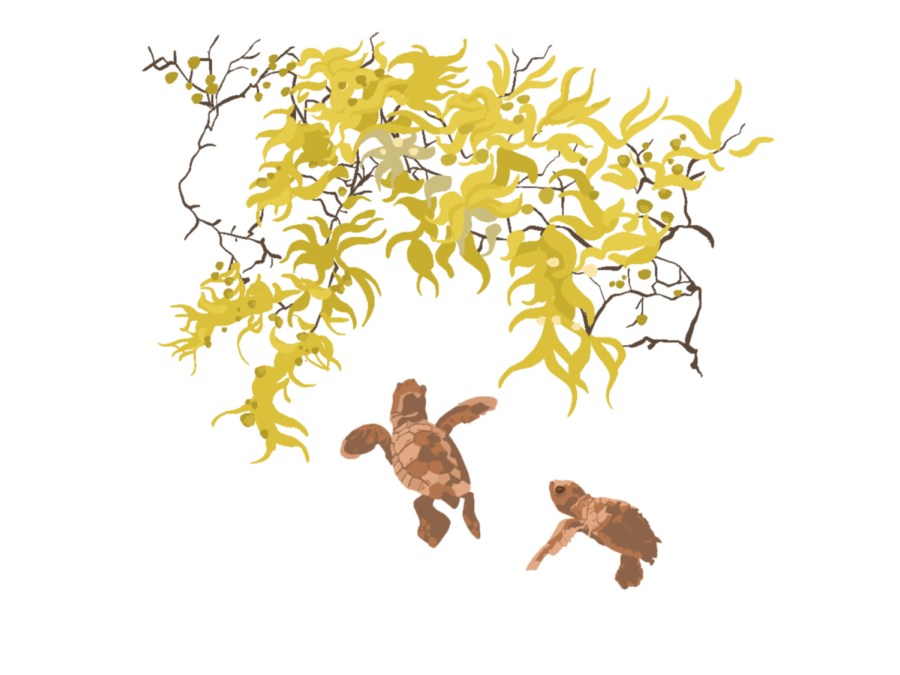Largest Recorded Belt of Open-Ocean Seaweed Hits Florida
May 25, 2023
A 5,000-mile-long belt of seaweed-laden water is currently surrounding Florida’s coasts. The mat of Sargassum washing up on Florida’s beaches is part of an annual cycle that has been tracked since 2011, but this year’s seaweed bloom is earlier and larger than ever recorded.
Every year vast amounts of S. natans and S. fluitans, floating species of brown algae, bloom in the Sargasso Sea in the western Atlantic Ocean and flow southwest to the coasts of Florida, Mexico and the Caribbean. Assistant Principal Glenn Webb, who graduated from Rollins College with a degree in environmental biology, explains what makes this year’s bloom unique.
“The bloom started early, in the wintertime, in fact,” Webb said. “Normally, it doesn’t start to bloom probably until spring or summer.”
Normally, excessive Sargassum can be removed from the beach with heavy machinery, but this year’s brown algae bloom presents an obstacle, according to Webb.
“So the normal way to clean it up will be with machines and rakes; you would go out and you would machine it,” Webb said. “Up in the panhandle, they bring out front-end loaders and big things, but all those possible ways of cleaning up the beach go away during sea turtle nesting season. And so during sea turtle nesting season, it can pile up and accumulate, sometimes feet thick, making it difficult for the turtles to get up to lay their eggs. And then if it’s still there, when turtles are hatching out, it makes it difficult for the juveniles to get back to the ocean.”
Social Studies teacher Sean Regan, however, said he believes the juvenile turtles will find a way to adapt.
“I think that they have an innate, God-given ability to climb over things as well,” Regan said. “Although I can picture it, as well, making it a little bit more difficult as far as things like the birds, it’ll be easier for them to unfortunately pick them off, but I mean, circle of life. It’s unfortunate in a sense.”
Regan, who said he visits the beach at least two times a week, said he believes the mat of seaweed should be left as a natural process.
“I think it’s kind of a wait and see approach. Part of my opinion is that you know, things get overblown a little bit sometimes because it’s good media stories,” Regan said. “It’s not something I’m overly concerned about because there’s actually a lot of marine life that thrive around that. In the open ocean, a lot of the marine life will hang out under that because it just creates a whole ecosystem underneath it.”
Webb said that, while open-ocean Sargassum acts as an ecologically essential nursery for maturing sea turtles and fish, it causes local environmental disruptions every year when it closes to shore, including by deoxygenating the water as it decomposes.
“It’s great when it’s out there in the middle of the ocean,” Webb said. “When it starts to drift in shallower waters where there are things that live on the bottom–corals, grasses–things like that, that require sunlight. If large amounts of [Sargassum] are covering, it can choke out some of the things that rely on photosynthesis. Also, when it dies, and it sinks to the bottom, it does provide nutrients to the things that live on the bottom as well, but in large amounts, you know, through the decay process, can cause harm to those environments.”
Junior Mehek Niwas, who has been working as a lifeguard for one year, said she believes the saturation of Florida waters with the seaweed will also reduce tourism.
“It doesn’t make it difficult to swim, it just makes it uncomfortable to swim,” Niwas said. “And people, like tourists, kind of don’t like swimming in that. It just makes going to the beach not fun for them.”
Niwas, however, said she doesn’t believe the Sargassum will pose a safety threat to visitors.
“Trying to save people, if you’re making a rescue, would be a little bit harder, but not that much,” she said. “I think it’d be the same number of rescues.”
Webb said he is concerned about the potential effects of reduced tourism due to the foul odor and harmful gases the seaweed releases, but said he is most concerned about the ecological impact of the early bloom.
“As a taxpaying citizen, we rely a lot on tourism dollars to fund a lot of the things that Florida has and so we do have an interest in what’s happening both from the, ‘oh man I want to go to the beach, but it smells bad’ to, ‘man, we really want to get this stuff done, but our tourism dollars are down,’” he said. “We are so prosperous, and it is an inconvenience, but those are recoverable. Whereas the ecological effects, it’s so fragile, and it’s a fine balance.”
Senior Grace Mandese said she is more worried about locals’ exposure to the smells and gases released by the Sargassum when it rots.
“I’m not worried about tourists not coming,” Mandese said. “Tourists create problems of their own, but the foul smell is bad for locals. I’m not concerned about my own exposure, but I am worried for people who have asthma or other lung problems that it’ll affect.”
Regan agrees that the danger to tourism should be taken as a secondary concern.
“It would hurt some businesses for sure, but also I don’t know the numbers and how much things like that would really, truly affect it long-term anyway,” he said. “I think more of the damage would be from people overcooking it a bit in the news and stuff like that. Because people are planning their vacations for a while, this is done months ahead of time by a lot of people up north that are coming down here. They’re going to come, most of them, anyway.”
As the seaweed decomposes on beaches, it releases hydrogen sulfide, according to the Florida Department of Health, which is described by the CDC as “highly toxic”. But Regan, who sponsors the Surf Club, said he is not concerned.
“When I was in high school, surfing, I lived on the Gulf Coast in high school and we’d have really bad red tide there, and we’d just put swimming goggles on and paddle out surfing if we needed to. It didn’t work very well by the way, but we would just deal with it. And same thing here. It’s just kind of something you deal with occasionally from time to time, it’s not the end of the world. So I’ll still go to the beach and go surf, I just maybe won’t wear a leash so it won’t get tangled up, that’s about it.”





















































